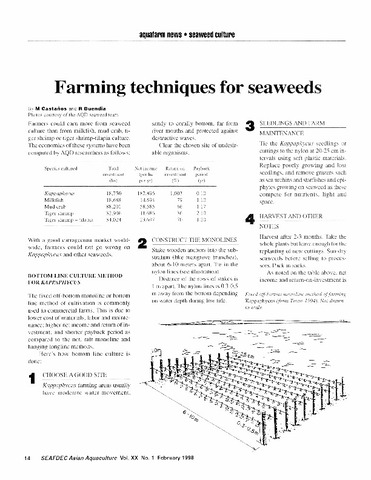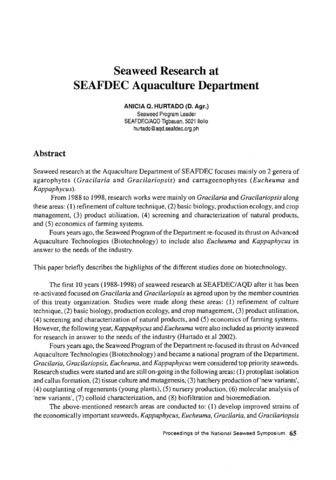Resiliency of Gracilariopsis heteroclada (Zhang et. Xia) carpospores at different salinity and temperature levels
- Global styles
- MLA
- Vancouver
- Elsevier - Harvard
- APA
- Help
Date
2019-07Author
Page views
587ASFA keyword
Taxonomic term
Geographic names
Metadata
Show full item record
Share
Abstract
Environmental factors like temperature and salinity play an important role in the growth and reproduction of aquatic organisms. The change in these two factors will be a major challenge in the future. Development of different culture techniques for Gracilariopsis heteroclada (Zhang et. Xia), a species usually found in the Philippines are being undertaken due to its increasing demand, however, there is a rapid depletion of natural populations. This study tested the resiliency of Gp. heteroclada to different water temperatures and salinities. Diploid spores from mature cystocarpic thalli of Gp. heteroclada were shed and grown at different temperatures and salinities under laboratory condition. Higher germination rate was obtained at 20°C (152.21 ± 69.88 carpospores) and 30°C (155.58 ± 66 carpospores) than at 40°C (7.56±6.54 carpospores) and 10°C (no spores were shed). Carpospores shed at 40°C degraded after 3 days. Growth rates of carpospores cultured on slides at 20 °C ranged from 2.37 to 5.92% day-1 while carpospores at 30°C ranged from 2.02 to 3.44% day-1. When carpospores were transferred to aerated vessels, growth rates decreased. At 20 °C, growth rates ranged from 0.84 to 2.96 % day-1 while at 30°C, growth rates ranged from 1.65 to 2.56 % day-1. Development rates had a wide range from 0.51 to 27.27% at 20 °C while at 30 °C, development rates ranged from 1.27 to 30 %. These results showed that Gp. heteroclada can shed carpospores at a range of 20-40 °C and 20-40 ppt. However, carpospores cannot fully develop at 40 °C. Optimum temperature for growth was at 20 °C and can grow at a wide range of salinity (20-40 ppt).
Suggested Citation
Mateo, J. P. (2019). Resiliency of Gracilariopsis heteroclada (Zhang et. Xia) carpospores at different salinity and temperature levels [Unpublished master’s thesis]. University of the Philippines Visayas.
Type
ThesisCollections
- Masters Theses [2]
Related items
Showing items related by title, author, creator and subject.
-
Farming techniques for seaweeds
Castaños, M.; Buendia, R. (Aquaculture Department, Southeast Asian Fisheries Development Center, 1998)Details are given of farming methods developed by the SEAFDEC Aquaculture Department for 3 different seaweeds: 1) Bottom line culture method for Kappaphycus; 2) Pond culture of Gracilaria; and, 3) Gracilariopsis bailinae, ... -
Seaweed research at SEAFDEC Aquaculture Department
Hurtado, Anicia Q. (Seaweed Industry Association of the Philippines, 2003)Seaweed research at the Aquaculture Department of SEAFDEC focuses mainly on 2 genera of agarophytes (Gracilaria and Gracilariopsis) and carrageenophytes (Eucheuma and Kappaphycus). From 1988 to 1998, research works were ... -
Improved growth performance of Gracilariopsis heteroclada via short-term nitrogen enrichment
This study examined the effect of short-term nitrogen (N) enrichment on Gracilariopsis heteroclada growth and agar quality. Planting materials were soaked in different concentrations of ammonium chloride (NH4Cl) ...







